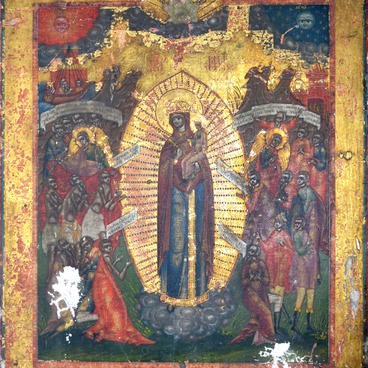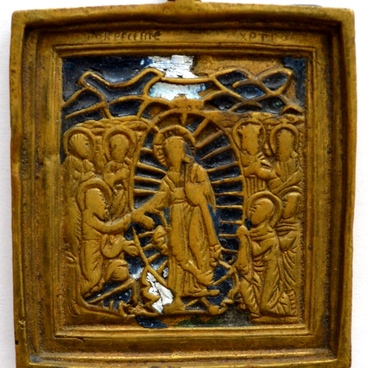The elements in the Descent into Hell icon are arranged in a strict order. The Twelve Feasts are depicted in the twelve border scenes around the centre. They make up four rows. Top row, left to right: The Old Testament Pentecost, Nativity of the Most-Holy Mother of God, the Entrance of the Most-Holy Mother of God into the Temple, the Annunciation. The Nativity of Jesus Christ and the Presentation of Our Lord in the Temple are in the second row. Row three includes the Theophany of Our Lord and the Transfiguration. In the bottom row, the Entrance of Our Lord into Jerusalem, the Ascension of Our Lord, the Dormition of the Most-Holy Mother of God and the Universal Exaltation of the Cross are depicted.
The central part of the icon represents the scene of Descent into Hell, where the Savior tramples down the crossed Gates of Hades. According to the Sacred Tradition, after the crucifixion, Christ descended into hell and liberated the souls imprisoned there. Above this scene, artists traditionally depicted the Resurrection. To the left of the Savior is usually Adam — Jesus holds him by the wrist. The iconography is based on the gospel narrative of God embodied inhuman form redeeming the original sin through his death.
This iconographic tradition was shaped in Moscow and then spread to the Volga region, mainly the cities of Yaroslavl and Kostroma. By the 18th century, this version of the image was adopted by Palekh icon painters. From then until the beginning of the 20th century, it was part of the icons of the Twelve Feasts and received its other name: Palekh.
The scenes of the Nativity of the Most-Holy Mother of God and the Entrance of the Most-Holy Mother of God into the Temple, placed above the scene of the Resurrection, narrate the life and mission of the immaculate Virgin who gave birth to the Savior.
The scenes of the Old Testament Pentecost, Epiphany, Theophany, and the Exaltation of the Cross complement the central scene. At the side of each scene, the painter added written explanations.
A large number of characters, bright colour patches, the abundance of gold in the border scenes and in the background were meant to convey the solemnity of the greatest Christian Feast: ‘Christ is risen from the dead, trampling down death by death, and on those in the tombs bestowing life’.

